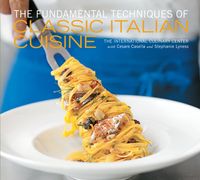Advertisement
Appears in
Whereas the production of pasta secca was industrialized for export long ago (probably as early as the fifteenth century), pasta fresca was traditionally a handmade product, made in homes, restaurant kitchens, and local shops called pastifici. (Today, it is also produced in factories.) Pasta fresca is usually rolled, then cut or shaped by hand. It is usually softer, with a more delicate texture than dried, and it cooks faster. (There are some notable exceptions, including the robust, hand-shaped Orecchiette.)

